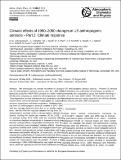Climatic effects of 1950–2050 changes in US anthropogenic aerosols – Part 2: Climate response
Author(s)
Leibensperger, Eric Michael; Mickley, L. J.; Chen, W. -T.; Seinfeld, J. H.; Nenes, A.; Adams, P. J.; Streets, D. G.; Kumar, N.; Rind, D.; ... Show more Show less
Download2-Leibensperger-2012-Climatic effects of.pdf (1.310Mb)
PUBLISHER_CC
Publisher with Creative Commons License
Creative Commons Attribution
Terms of use
Metadata
Show full item recordAbstract
We investigate the climate response to changing US anthropogenic aerosol sources over the 1950–2050 period by using the NASA GISS general circulation model (GCM) and comparing to observed US temperature trends. Time-dependent aerosol distributions are generated from the GEOS-Chem chemical transport model applied to historical emission inventories and future projections. Radiative forcing from US anthropogenic aerosols peaked in 1970–1990 and has strongly declined since due to air quality regulations. We find that the regional radiative forcing from US anthropogenic aerosols elicits a strong regional climate response, cooling the central and eastern US by 0.5–1.0 °C on average during 1970–1990, with the strongest effects on maximum daytime temperatures in summer and autumn. Aerosol cooling reflects comparable contributions from direct and indirect (cloud-mediated) radiative effects. Absorbing aerosol (mainly black carbon) has negligible warming effect. Aerosol cooling reduces surface evaporation and thus decreases precipitation along the US east coast, but also increases the southerly flow of moisture from the Gulf of Mexico resulting in increased cloud cover and precipitation in the central US. Observations over the eastern US show a lack of warming in 1960–1980 followed by very rapid warming since, which we reproduce in the GCM and attribute to trends in US anthropogenic aerosol sources. Present US aerosol concentrations are sufficiently low that future air quality improvements are projected to cause little further warming in the US (0.1 °C over 2010–2050). We find that most of the warming from aerosol source controls in the US has already been realized over the 1980–2010 period.
Date issued
2012-04Department
Massachusetts Institute of Technology. Department of Earth, Atmospheric, and Planetary SciencesJournal
Atmospheric Chemistry and Physics Discussions
Publisher
Copernicus GmbH
Citation
Leibensperger, E. M. et al. “Climatic Effects of 1950-2050 Changes in US Anthropogenic Aerosols -Part 2: Climate Response.” Atmospheric Chemistry and Physics 12.7 (2012): 3349–3362.
Version: Final published version
ISSN
1680-7375
1680-7367